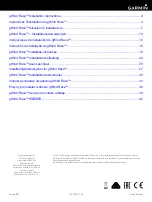
9
UHF Belt-Pack Transmitter
Rio Rancho, NM – USA
Transmitter
Input Jack
4
3
2
1
5
LECTROSONICS
1uH
10K
1K
5
100
4
3
2
1
330PF
330PF
+
5V Mic Bias
5mA max
To Mic Amp
POS BIAS (OR GND)
MIC
SOURCE LOAD
LINE IN
NEG GND (OR BIAS)
UHF Transmitter Equivalent Input Circuit
5-PIN INPUT JACK WIRING
The wiring diagrams shown on the separate sheet represent the basic wiring necessary for the most common types
of microphones and other audio inputs. Some microphones may require extra jumpers or a slight variation on the
diagrams shown.
Caution
- When wiring the connector, do not use the connector body for any electrical connections.
A common mistake is to use the connector body as an audio ground. The connector body is
already used as an RF ground on VHF models and no other use is permitted.
It’s virtually impossible to keep completely up to date on changes that other manufacturers make to their products. It
is possible that you may encounter a microphone that differs from these instructions. If this occurs please call our toll-
free number listed on page 13 of this instruction manual. Our service department can answer your questions regard-
ing microphone compatibility.
When used on a wireless transmitter, the microphone element is in the proximity of the RF coming from the transmit-
ter. The nature of electret microphones makes them sensitive to RF, which can cause problems with the microphone/
transmitter compatibility. If the electret microphone is not designed properly for use with wireless transmitters, it may
be necessary to install a chip capacitor in the mic capsule or connector to block the RF from entering the electret
capsule. This modification is shown on the next page.
VHF transmitters use the shield of the microphone cord as the antenna. The UM195B uses a 1/4 wave flexible wire to
radiate the RF signal. There is really not much difference between these two approaches, with respect to the effect of
the RF on the microphone capsule. Even in transmitters that utilize a “dangling wire,” the microphone is still part of
the “ground plane” and is therefore still in the antenna circuit.
PIN 1
Shield (ground) for positive biased electret lavalier microphones. Bias voltage source for negative biased
electret lavalier microphones. Shield (ground) for dynamic microphones and line level inputs.
PIN 2
Shield (ground) for negative biased electret lavalier microphones. Bias voltage source for positive biased
electret lavalier microphones.
PIN 3
Low impedance microphone level input for dynamic microphones. Also accepts hand-held electret micro-
phones provided the microphone has its own built-in battery.
PIN 4
1K Ohm source load for non-Lectrosonics electret microphones. Use in conjunction with other pins to provide
attenuation of high level input signals.
PIN 5
High impedance, line level input for tape decks, mixer outputs, musical instruments, etc.
































